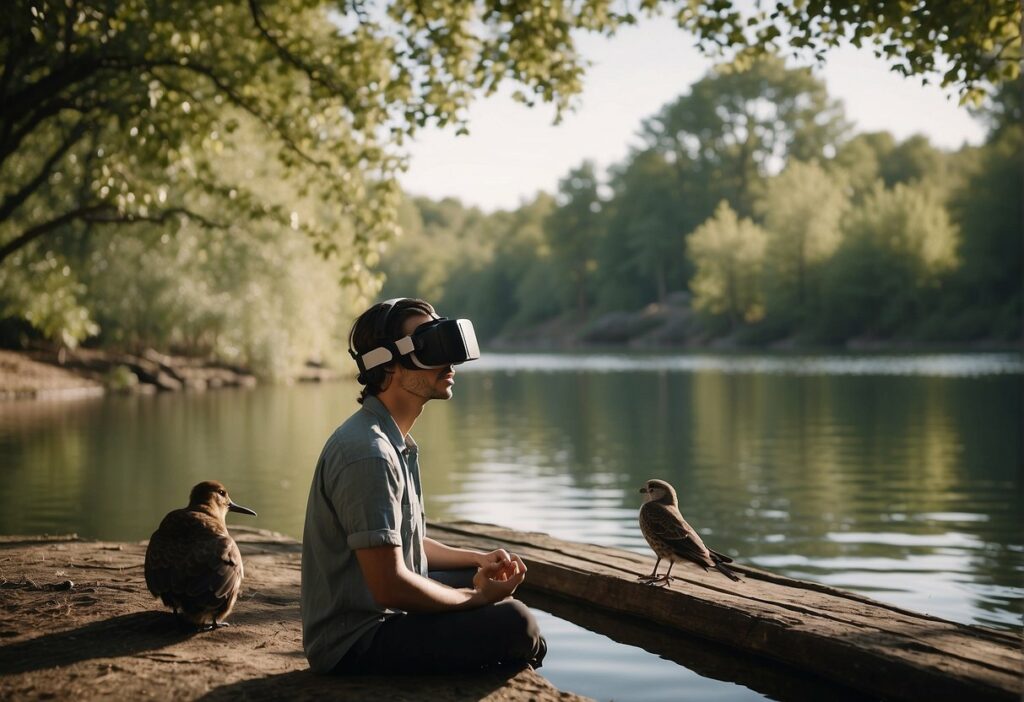Virtual Reality as a Tool for Mindfulness and Stress Reduction: Exploring Calm in a Digital Age

Virtual reality technology has expanded beyond its entertainment roots and is now offering new pathways for mindfulness and stress reduction.
By creating immersive environments and simulations, virtual reality provides users with a unique means of achieving relaxation and mental clarity. This application of VR taps into the principles of guided meditation and controlled environments, enabling individuals to break away from the stressors of their daily lives and engage in deep relaxation practices.
Recent studies have found that using VR as a tool for mindfulness can effectively reduce anxiety and enhance emotional well-being. The technology’s ability to transport users to serene landscapes or peaceful scenarios, coupled with guided meditation exercises, has proven to complement traditional stress reduction techniques.
Users can customize their experience, choosing settings and scenarios that resonate personally with them, thus fostering a more individualized approach to mindfulness.
In the healthcare sector, VR mindfulness programs are being adopted to assist patients in pain management and emotional coping strategies. The technology’s application shows promise in not only providing relief in clinical settings but also in enabling individuals to incorporate mindfulness practices into their daily lives. As VR devices become more accessible, their potential as a versatile tool in enhancing mental health continues to grow.
The Science of Mindfulness and Stress Reduction

Mindfulness has been scientifically validated as a means to reduce stress levels, and recently, virtual reality (VR) has emerged as an innovative tool in mindfulness practices and psychotherapy.
Understanding Mindfulness
Mindfulness is the practice of being fully present and engaged in the moment, aware of one’s thoughts and feelings without judgment. Studies have shown that mindfulness meditation can lead to structural changes in the brain, particularly in regions related to attention, emotion regulation, and self-awareness. These changes are associated with reduced stress and improved well-being. Key aspects include:
- Focused Attention
- Nonjudgmental Awareness
- Present-Moment Orientation
Stress and the Human Mind
The human mind perceives stress as a threat, prompting physiological and psychological responses that can be detrimental over time. Chronic stress is linked to numerous health issues, including heart disease, depression, and autoimmune disorders. Mindfulness interventions can mitigate the stress response by:
- Reducing cortisol levels
- Lowering blood pressure
- Enhancing immune function
Role of Virtual Reality in Psychotherapy
Virtual reality in psychotherapy utilizes immersive environments to aid in the treatment of psychological conditions. It allows patients to confront and work through issues within a controlled setting. VR can be particularly effective in the application of mindfulness techniques:
- Providing an immersive and distraction-free environment
- Tailoring mindfulness experiences to individual needs
- Tracking progress with interactive and measurable sessions
VR’s capability to create a controlled, engaging setting for mindfulness practices shows promising potential to enhance stress reduction therapies.
Virtual Reality Technology for Mindfulness

Virtual reality (VR) is reshaping mindfulness practices by offering immersive environments that facilitate focus and calm.
Current VR Technology
Headsets and Applications: Today’s VR technology primarily includes head-mounted displays (HMDs) like the Oculus Quest and HTC Vive, alongside mindfulness applications that create serene settings. Users find themselves transported to digitally crafted, peaceful landscapes where guided meditations and breathing exercises help them to destress.
Accessibility and User Experience: Modern VR devices have become more accessible, with wireless options and intuitive user interfaces. They cater to a diverse audience seeking mindfulness training without the constraints of physical location. Comfort is enhanced through ergonomic design, reducing barriers to long sessions of stress-reducing VR meditation.
Advances in Immersive Experiences
Sensory Integration: Advanced systems are integrating multisensory feedback — haptic, olfactory, and auditory — to deepen the immersion. This multisensory stimulation reinforces the user’s presence in virtual settings, effectively enhancing the relaxation and mindfulness experience.
Customization and AI: Integrated artificial intelligence (AI) allows apps to personalize experiences, adapting scenarios in real-time to user reactions and preferences. The AI monitors stress levels and adjusts the environment accordingly, tailoring the meditative journey to individual needs and optimizing the potential for stress reduction.
Implementing VR Mindfulness Programs

Virtual Reality (VR) presents a unique medium for mindfulness programs by offering immersive environments conducive to relaxation and stress reduction. Effective implementation requires carefully crafted content and an understanding of potential barriers to user adoption.
Designing Mindfulness Programs
To design an impactful VR mindfulness program, creators must first define clear objectives targeting stress reduction and emotional well-being. Content should consist of guided meditations, calming visuals, and auditory stimuli to induce a meditative state. For example, a session could transport a user to a serene forest with a gentle stream and soft-spoken instructions on breathing techniques.
Program structure is another critical component. A well-structured program might look like this:
- Introductory Session: Overviews the VR mindfulness experience.
- Guided Sessions: Series of progressive mindfulness exercises.
- Freeform Exploration: Allows users to choose environments and sessions based on preference.
Further, feedback mechanisms are integral for refining these programs. These can include user surveys or data analytics to track engagement levels and stress markers.
Accessibility and Adoption Challenges
The adoption of VR mindfulness programs faces hurdles:
- Cost of VR Technology: High-priced VR headsets can limit accessibility for users. To mitigate this, institutions might offer shared VR spaces or explore subsidizing costs.
- Technological Proficiency: Users unfamiliar with VR may need support through tutorials or staff assistance.
- Physical Comfort: Some individuals may experience motion sickness in VR. Offering varied content with different levels of motion can help cater to diverse users.
Awareness is also crucial. Institutions should educate potential users about the benefits of VR for mindfulness to encourage trial and adoption. This can entail:
- Seminars or workshops.
- Informative brochures and online resources.
By addressing these challenges, providers can enhance the reach and impact of VR mindfulness programs, aiding individuals in managing stress and improving mental health.
Case Studies and Research Findings

Research in the intersection of virtual reality (VR) and mindfulness has yielded promising results indicative of VR’s potential in stress reduction and mental health.
Effectiveness of VR Mindfulness
A 2018 study by Gutiérrez-Maldonado et al. found that participants using VR for mindfulness exercises reported a significant reduction in their levels of anxiety. This study involved 30 minutes of VR mindfulness practice across five sessions and demonstrated a decrease in the participants’ self-reported stress scores.
Recent research in 2021 by Chan et al. showcased how mindfulness delivered through VR could enhance the presence and immersion, which are critical for effective mindfulness practice. This experiment included a sample group of 60 individuals spanning four weeks of VR mindfulness sessions, highlighting a marked improvement in stress management and cognitive focus.
Comparative Studies with Traditional Practices
Research conducted by Klisanin in 2020 compared VR mindfulness programs with conventional mindfulness practices over an eight-week period. The results indicated that while both groups experienced stress reduction, the VR group reported a higher level of engagement and easier immersion into the mindfulness exercises.
Another study in 2022 involving a direct comparison of traditional face-to-face mindfulness training with VR-assisted mindfulness training revealed that both modalities were equally effective in reducing symptoms of psychological stress. However, participants in the VR group noted a preference for the accessibility and convenience of VR sessions.
These case studies suggest that VR holds considerable potential as an effective tool for mindfulness and stress reduction, comparable to traditional practices.
Future Directions in VR Mindfulness

Virtual Reality (VR) continues to advance, offering new possibilities for mindfulness and stress reduction. These developments are expected to enhance the user experience and broaden the therapeutic impact of VR.
Technological Innovations
Advancements in sensory feedback and AI are anticipated to revolutionize VR mindfulness experiences. Future devices may include:
- Haptic feedback suits, enabling users to feel virtual environments.
- Olfactory output, providing scent cues that enhance immersion.
These innovations aim to deepen the sense of presence in VR, making mindfulness practices more effective. Additionally, Artificial Intelligence will likely play a pivotal role in personalizing experiences, with systems designed to adapt scenarios in real-time based on user reactions and needs.
Potential Psychosocial Impacts
The integration of VR into mindfulness practices is poised to yield significant psychosocial benefits:
- Accessibility: VR may bring mindfulness to diverse populations, facilitating techniques for those who may not engage with traditional methods.
- Community: Shared VR spaces could foster a sense of community, offering group sessions and peer support in a virtual setting.
These impacts have the potential to not only reduce stress but also to improve overall mental health and social connections. As such, researchers and developers are focusing on ethical frameworks to ensure these tools are used responsibly.
